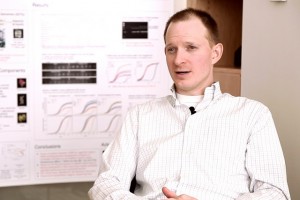Bilingualism
Psychologist Ellen Bialystok on simultaneous learning of different writing systems, cognitive reserve, and mul...
I have no doubt that my hand, my head, and my nose belong to me. This body is my body, and possibly you feel your body to be your body and nobody else’s body. But possibly, this feeling of ownership is a feeling that we construct every second of our life in our brains. It is not given by nature; it is constructed. But if it is constructed, can we change it? The answer is yes.
Let’s make a very, very simple experiment. If you want to read more about it, just go to your computer and type in ‘rubber hand illusion’; you will see lots of nice videos of this very simple illusion. You can test it on yourself: it works. What you need is a rubber hand. It’s easy for you to see that this rubber hand is not your body: it is made of rubber, so it’s an artificial hand. So the experimenter asks you to just look at this rubber hand and meanwhile put your own hand behind a partition wall, so you shouldn’t be able to see it. Now comes a person who has brushes in both hands. With one hand, they stroke the thumb of the rubber hand, and with the other hand, they simultaneously stroke your thumb. So you’re looking at the stroking movements on the thumb of the rubber hand, and you’re feeling the same movements and the same touch on your real hand. Then they go with the rubber hand index finger and your index finger, rubber hand middle finger and your middle finger, etc.
So, what is the language of your brain? The language of your brain is the synchronicity of nerve impulses. When the visual aspect of stroking is synchronous with the felt aspects of stroking, you have nerve cells that are synchronously active: visual cells, some other sensory cells, etc. These nerve impulses are jointly coming together in the brain, creating the feeling that this is part of your body. That means that you can change the way you think about your own body.
You can even go further. Swiss scientists have done a beautiful experiment. They asked subjects to enter their laboratory and put on virtual reality glasses. The only thing that these people could see was themselves standing in front of them with a back towards them. It’s very simple: there was a camera behind them taking a picture of them standing in the lab. So that’s what these people saw: they saw themselves standing in front of them. Obviously, they understood that this was just the picture of the camera and not themselves. And now comes the trick: the Swiss scientists took a long stick and stroked the subjects on their backs. What the people saw with their virtual reality device was the same stroking movement at the back of the person in front of them: a synchronous feeling of some other sensory input and the visual aspect of seeing this in front of them. And what subjects report is it feels like also standing there – being in front of you. This is very strange.
Does this also reflect diseases of the human brain where people, for example, after brain damage, have changes in the way they perceive their own body? Yes, especially of the lesions of the right part of the brain. Some patients report that this is not their hand; it’s the hand of somebody else.
After the brain lesion people can have the feeling of not being able to accept their own left hand as part of their body. In most extreme cases some people say, ‘This left hand makes me unhappy, please cut it off, it doesn’t belong to me, it’s not part of my body’.
In other patients with epileptic seizures, there are reports that these people say during the seizure that somebody moves into their body, so for a few minutes, the left part of their body is in the control of somebody else, and it is somebody else, while the other part of the body in them.
All of that shows that we construct ourselves, and this construction can change with lesions of the brain and with simple procedures like rubber hand illusions. That would now imply that the feeling of me, of myself, is something that can change in a second. There is also some stability involved. It’s a strange thing to be somebody else and be stable in me. What does that mean? It means the following: I give you an example from a person in Switzerland again who, unfortunately, died a couple of years ago. She had a genetic disease: she was born without arms and without hands, so never in her life, she had a body schema including arms and legs. In other words, it’s not that she had arms when she was young, and they were lost in an accident: she never ever had them. But now listen to what she reports: she says, ‘Sometimes when I have free time, I sit on my sofa, I put my legs onto the pillow, and I enjoy my life. And when somebody comes into the room and sits on my legs, in that second, my legs disappear, but when the person stands up, the legs are there again’.
What does that all mean? It means that we are born with a body in our brain, and this body in our brain has a certain stability over life. But when we sometimes have a major brain injury, we can think that this is no longer our arm or hand, and when we speak the language of the brain, which is synchronicity, we can alter the body map of our body within seconds. At that level, I am a construction, and you are also a construction every second of your life.

Psychologist Ellen Bialystok on simultaneous learning of different writing systems, cognitive reserve, and mul...

Neuroscientist Karl Friston on the Markov blanket, Bayesian model evidence, and different global brain theorie...

MIT Research Scientist Christopher Carr on challenges of distant journeys, components of cosmic radiation, and...